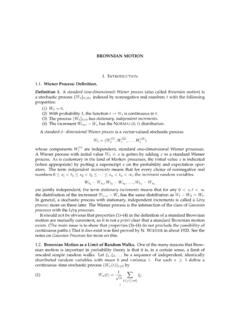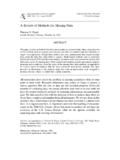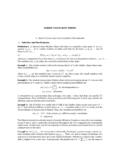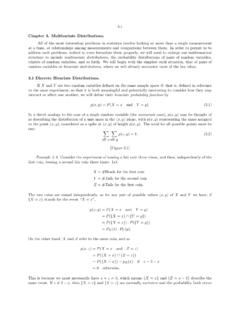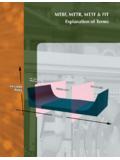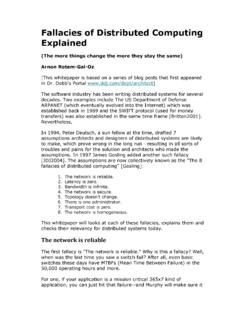Transcription of Prologue - University of Chicago
1 LECTURE 5: BROWNIAN have seen in previous lectures that, for discrete multiperiod markets which admit no arbi-trages, there existequilibrium distributions. Under an equilibrium distribution, the discounted priceprocess of any traded or tradeable asset is amartingaleunder the natural filtration. In fact, thisis true in even greater generality the hypothesis that the market bediscrete(that is, that therebe only finitely many market scenarios) is unnecessary. The proof of this more general statement(which we shall not give) follows essentially the same strategy as in the discrete case, and uses littlemore than the technical properties of conditional expectation given in Lecture real markets, trading takes place in continuous time.
2 Problems of pricing and hedging de-rivative securities in continuous time markets require continuous time (and therefore necessarilynon discrete) models of markets and securities prices. This is where Brownian motion and the It ocalculus enter the picture. This lecture and the next will be devoted to introducing the mathemat-ical theory of these might wish to have some purely economic explanation for the occurrence of Brownian motionand It o processes in the theory of asset pricing before investing the substantial effort necessary tomaster the basics of their mathematical theory.
3 Briefly, the explanation is this. In equilibrium,the discounted price process of any tradeable asset, observed at discrete times, is a martingale;therefore, incontinuoustime, it is also a martingale (see below for a discussion of continuous timemartingales). Moreover, the prices of traded assets seem to vary continuously with time1and seemto have finitequadratic variation(see below). Brownian motion now rears its head for the followingbasic reason, a fundamental theorem ofPaul L evy:Theorem continuous time martingale with continuous paths and finite quadratic varia-tion is a time changed Brownian proof is beyond the scope of this course.
4 (You may find it inKaratzas & Shreve,Brow-nian Motion and Stochastic Calculus, ch. 2.) We quote it here merely to justify the introductionof Brownian Motion: DefinitionDefinition Brownian(or astandard Wiener process) is a stochastic process{Wt}t 0+(that is, a family of random variablesWt, indexed by nonnegative real numberst, defined on a com-mon probability space( ,F, P)) with the following properties:(1)W0= 0.(2)With probability1, the functiont Wtis continuous int.(3)The process{Wt}t 0hasstationary, independent increments.(4)The incrementWt+s Wshas theNormal(0, t) , along with the technical assumption that price processes have finite quadratic variation, is somewhatcontroversial.
5 Discrepancies between theoretical (Black Scholes) and actual prices of derivative securities may in factbe due to the failure of one or both of these assumptions in real termindependent incrementsmeans that for every choice of nonnegative real numbers0 s1< t1 s2< t2 sn< tn< ,theincrementrandom variablesWt1 Ws1, Wt2 Ws2, .. , Wtn Wsnare jointly independent; the termstationary incrementsmeans that for any 0< s, t < thedistribution of the incrementWt+s Wshas the same distribution asWt W0= should not be obvious that properties (1) (4) in the definition of a standard Brownian motionare mutually consistent, so it is nota prioriclear that a standard Brownian motion exists.
6 (Themain issue is to show that properties (3) (4) do not preclude the possibility of continuous paths.)That itdoesexist was first proved byN. Wienerin about 1920. But notice that properties (3) and(4) are compatible. This follows from the following elementary property of the normal distributions:IfX, Yare independent, normally distributed random variables with means X, Yand variances 2X, 2Y, then the random variableX+Yis normally distributed with mean X+ Yand variance 2X+ Motion as a Limit of Random WalksOne of the many reasons that Brownian motion is important in probability theory is that itis, in a certain sense, a limit of rescaled simple random walks.
7 Let 1, 2, ..be a sequence ofindependent, identically distributed random variables with mean 0 and variance 1. For eachn 1define a continuous time stochastic process{Wn(t)}t 0by(1)Wn(t) =1 n 1 j bntc jThis is a random step function with jumps of size k/ nat timesk/n, wherek Z+. Sincethe random variables jare independent, the increments ofWn(t) are independent. Moreover, forlargenthe distribution ofWn(t+s) Wn(s) is close to theNormal(0, t) distribution, by theCentral Limit theorem. Thus, it requires only a small leap of faith to believe that, asn ,the distribution of the random functionWn(t) approaches (in a certain sense)2that of a standardBrownian is this important?
8 First, it explains, at least in part, why the Wiener process arises socommonly in nature. Many stochastic processes behave, at least for long stretches of time, likerandom walks with small but frequent jumps. The argument above suggests that such processeswill look, at least approximately, and on the appropriate time scale, like Brownian , it suggests that many important statistics of the random walk will have limitingdistributions, and that the limiting distributions will be the distributions of the correspondingstatistics of Brownian motion.
9 The simplest instance of this principle is the central limit theorem:the distribution ofWn(1) is, for largenclose to that ofW(1) (the gaussian distribution with mean0 and variance 1). Other important instances do not follow so easily from the central limit example, the distribution of(2)Mn(t) := max0 s tWn(t) = max0 k nt1 n 1 j k j2 For a formal definition of convergence in distribution of random functions, together with detailed proofs andmany examples and statistical applications, seeBillingsley, , asn , to that of(3)M(t) := max0 s tW(t).
10 Similarly, for anya >0 the distribution of(4) n(a) := min{t 0 :Wn(t) a}approaches, asn , that of(5) (a) := min{t 0 :W(t) =a}.The distributions ofM(t) and (a) will be calculated ProbabilitiesThe mathematical study of Brownian motion arose out of the recognition by Einstein that therandom motion of molecules was responsible for the macroscopic phenomenon ofdiffusion. Thus, itshould be no surprise that there are deep connections between the theory of Brownian motion andparabolic partial differential equations such as the heat and diffusion equations.
